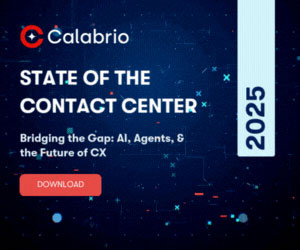Calabrio explores how mid-to-large contact centres can turn workforce forecasting from a frustrating guessing game into a strategic advantage that reduces costs, improves agent engagement, and delivers consistently better customer experiences.
Right now, contact centres face unprecedented workforce challenges. With agent attrition rates averaging more than 30% and customer expectations at all-time highs, getting your staffing right isn’t just a planning exercise; it’s a business imperative.
For operations leaders, the daily reality can be painful: constantly juggling overstaffed periods with sudden, unexpected rushes.
Your agents burn out during volume spikes while finance questions why you need all those people during quieter periods. Meanwhile, customer satisfaction scores fluctuate unpredictably, and service levels remain frustratingly inconsistent.
Most contact centres still rely on outdated spreadsheets or disconnected systems for what should be their most strategic planning activity.
The manual workarounds eat up valuable time, the lack of visibility creates anxiety, and the inevitable forecasting misses lead to rushed hiring or emergency schedule changes that frustrate everyone involved.
Here’s everything you need to know about predicting staffing needs in your workflow.
Key Takeaways
- Workforce forecasting aligns staffing with fluctuating demand, improving customer experience, controlling labour costs, and reducing agent burnout.
- Modern forecasting methods, like time series analysis, regression modelling, and scenario planning, outperform outdated spreadsheets and manual guesswork.
- Tracking historical data, business drivers, productivity metrics, and external factors ensures more accurate, actionable staffing forecasts.
- Cross-functional collaboration, targeted forecasting scopes, and continuous improvement cycles are essential for building a resilient workforce forecasting strategy.
What is Workforce Forecasting?
Workforce forecasting is the systematic process of analysing historical data, current trends, and future business projections to predict an organization’s staffing needs.
It goes beyond simple headcount planning to encompass skills requirements, labour costs, productivity levels, and talent availability.
At its core, effective forecasting answers critical questions that keep operations leaders up at night:
- How many agents will we need in each department or skill group next quarter?
- What happens to our service levels if that marketing promotion succeeds?
- How will seasonal patterns affect our staffing requirements?
- Which emerging skill gaps might impact our ability to meet customer expectations?
Why Workforce Forecasting is Important
For contact centres managing hundreds or thousands of agents, the financial stakes of forecasting accuracy are enormous.
Beyond the obvious cost benefits, accurate forecasting transforms contact centre performance across multiple dimensions:
- Elevated Customer Experience: When contact volume predictions align with staffing, shorter wait times, fewer abandons, and more consistent service become the norm rather than occasional wins.
- Increased Agent Retention: Workload balance prevents both the burnout of understaffing and the boredom of overstaffing. Agents notice this stability, and your attrition numbers reflect it.
- Enhanced Operational Agility: Scenario-based planning allows contact centers to adapt quickly to market shifts, promotional campaigns, or unexpected events while maintaining service continuity.
- Strengthened Strategic Value: Leadership gains confidence in the organization’s ability to scale operations predictably to support growth initiatives or manage challenging transitions.
Key Methods for Workforce Forecasting
Contact centres can employ several proven methodologies for workforce forecasting, each with distinct advantages for different situations. The most effective approach typically combines multiple methods tailored to your specific needs.
Time Series Analysis
This approach looks at past contact history to find patterns, seasonal trends, and recurring cycles that help predict future volume. It works best for contact centres with consistent patterns and plenty of historical data.
Time series forecasting might reveal that your contact center consistently experiences 15% higher volume on Mondays or that chat interactions spike by 30% during promotional periods. These insights become the foundation for more accurate scheduling.
Modern WFM platforms can automatically detect these patterns across multiple channels and interaction types, creating more nuanced forecasts than possible with manual analysis.
Regression Analysis
Regression models identify relationships between contact volume and key business drivers like marketing campaigns, billing cycles, product launches, or external events.
For example, regression analysis might establish that every 1,000 new customer acquisitions generates approximately 150 additional support contacts in the following month.
This method helps contact centres create predictive formulas that connect business forecasts to staffing requirements.
It is particularly valuable for operations teams that need to translate executive growth projections into hiring plans.
Driver-Based Forecasting
This hybrid approach identifies key business metrics (drivers) that influence staffing needs and establishes their relationship to workforce requirements through both quantitative analysis and operational expertise.
Driver-based forecasting connects contact center planning directly to broader business indicators like sales volumes, customer growth, product usage, or service changes. This creates alignment with finance and operations while improving forecast accuracy during periods of business change.
Scenario Planning
Scenario planning, also known as “what if” modeling, develops multiple detailed forecasts based on different possible futures, such as baseline growth, rapid expansion, or unexpected challenges. Each scenario includes corresponding staffing models and action plans.
This approach helps contact centres prepare for uncertainty and identify common staffing needs across different potential futures.
It’s particularly valuable during periods of business transformation, market volatility, or when testing the impact of different strategic options.
This blog post has been re-published by kind permission of Calabrio – View the Original Article
For more information about Calabrio - visit the Calabrio Website
Call Centre Helper is not responsible for the content of these guest blog posts. The opinions expressed in this article are those of the author, and do not necessarily reflect those of Call Centre Helper.
Author: Calabrio
Reviewed by: Rachael Trickey
Published On: 30th Jun 2025
Read more about - Guest Blogs, Calabrio






 The digital foundation of a customer-centric contact centre, the Calabrio ONE workforce performance suite helps enrich and understand human interactions, empowering contact centres as a brand guardian. Calabrio ONE unites workforce optimisation (WFO), agent engagement, and business intelligence solutions into a cloud-native, fully integrated suite.
The digital foundation of a customer-centric contact centre, the Calabrio ONE workforce performance suite helps enrich and understand human interactions, empowering contact centres as a brand guardian. Calabrio ONE unites workforce optimisation (WFO), agent engagement, and business intelligence solutions into a cloud-native, fully integrated suite. 








